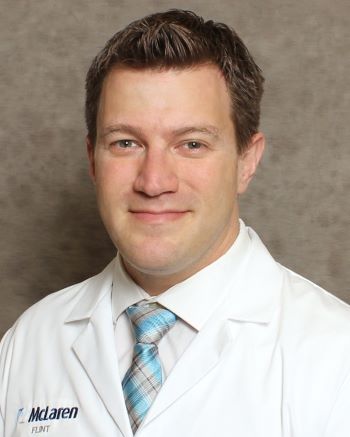Author: Sherry Farney
One of three culprits could be causing the pelvic, back, and abdominal pain or discomfort women experience regularly. In addition to the monthly symptoms brought on by menstrual cycles, uterine fibroids, and endometriosis can cause additional physical suffering. Deciphering and diagnosing may take some time, but patients are encouraged to fight for the answers they deserve.
“Your physician should believe in your pain and work with you to determine the cause,” said Brian Tesler, MD, FACOG, board-certified obstetrician and gynecologist at McLaren Flint. “It can take a bit of detective work but it’s important to have a correct diagnosis so women can get the help they need to avoid suffering for years.”
What are some of the differentiating factors between uterine fibroids and endometriosis?
Uterine fibroids are most often non-cancerous growths that can develop during a woman’s childbearing years. Their cause is still unknown, but risk factors include a family history of fibroids, obesity, and early onset of puberty. Fibroids that become large may cause heaviness or pressure in the lower abdomen or pelvis. Approximately one in three women with fibroids will have heavy or painful menstrual cycles. They can be discovered during a routine pelvic exam, through a variety of imaging options, laparoscopy - a scope that is inserted into a tiny incision in or near the navel, or a hysteroscopy - a scope that is inserted through the vagina and cervix into the uterus.

Thanks to a recent social media post by Bindi Irwin, daughter of the late, infamous ‘Crocodile Hunter’ Steve Irwin, endometriosis awareness is now a hot topic. A celebrity in her own right, Bindi revealed at the young age of 24 she’s been suffering from this health condition for a decade and is finally able to celebrate her diagnosis and treatment.
Endometriosis occurs when tissue similar to that found in the lining of the uterus grows outside of the organ. According to the Office on Women’s Health, it may affect more than 11 percent of American women between 15 and 44. Although endometriosis is most common in women in their 30s and 40s, Irwin is an example of someone whose symptoms began at a very young age. The growths may feel and bleed like the lining inside of the uterus does each month during the menstrual cycle. That can cause swelling and pain because endometriosis grows in areas where the blood cannot easily get out of the body.
Common endometriosis symptoms can include:
- Pain that can occur as menstrual cramps.
- Lower back, pelvic, or intestinal pain.
- Pain during or after intercourse.
- Painful bowel movements or pain when urinating during menstrual periods.
- Bleeding or spotting between periods.
- Infertility or inability to get pregnant.
- Stomach or digestive issues, especially during periods, including diarrhea, constipation, bloating, or nausea.
Treatment options for both endometriosis and uterine fibroids include medications and surgery.
“Whether it comes from a celebrity, a family member, or a friend, creating awareness of these common but often challenging conditions is a good thing,” said Dr. Tesler. “It can be difficult because of the different types of pain they cause, which may mimic other health conditions. Don’t be shy about advocating for yourself, and know that there are good treatment options available for you.”
If you are suffering from pelvic pain, McLaren Flint is holding a free program on the topic featuring Dr. Tesler on May 17, 2023. Registration is required and can be made here. If you are in need of a women’s health specialist, learn more here.